New Mexico is home to a diverse array of snakes, each adapted to its unique habitat. Among them, the New Mexico Ridge-Nosed Rattlesnake stands out, listed as a “Threatened Species” due to habitat loss. The Trans-Pecos Blind Snake, a secretive species, thrives underground, while the Western Diamondback Rattlesnake, a desert dweller, commands attention with its venomous strike.
From the secretive blind snakes to the iconic rattlesnakes, New Mexico’s snake population contributes to the rich biodiversity of its landscapes.
The article below provides a list of 53 common snake species found in New Mexico, many of which are venomous.
Different Species of Snakes in New Mexico
Glossy Snake
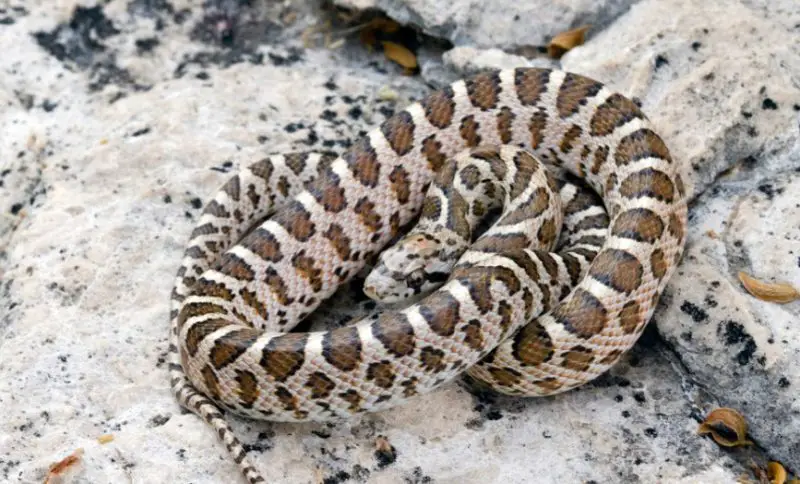
The Glossy Snake (Arizona elegans), also known as the Faded Snake, belongs to the Colubridae family. Ideal for beginners, these nocturnal creatures reach 30 to 50 inches and live 10 to 18 years. They have tan to light brown bodies with a glossy finish and brown blotches. Their underside is cream or pale yellow. Costing around $40, these calm, slow-moving snakes thrive in dry areas and feed on lizards, rodents, and birds by constriction.
Black Racer
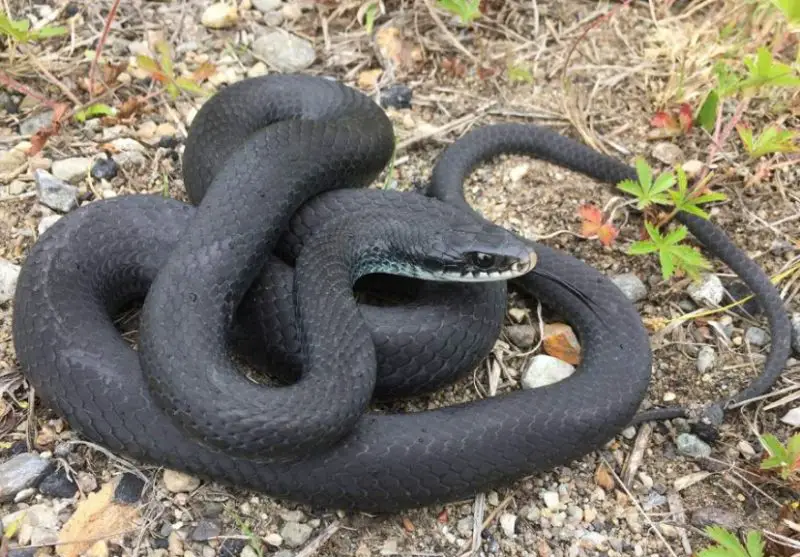
The Northern Black Racer (Coluber constrictor constrictor), part of the Colubridae family, is suitable for intermediate keepers. Known for its solid black, matte scales and white chin, this snake grows 33 to 65 inches and lives about 10 years. Priced around $40, it can be defensive if startled. Preferring brushy habitats like grasslands and fields, they feed on toads, birds, rodents, and other small animals. They are active travelers and not ideal for tank living.
Northern Trans-Pecos Rat Snake
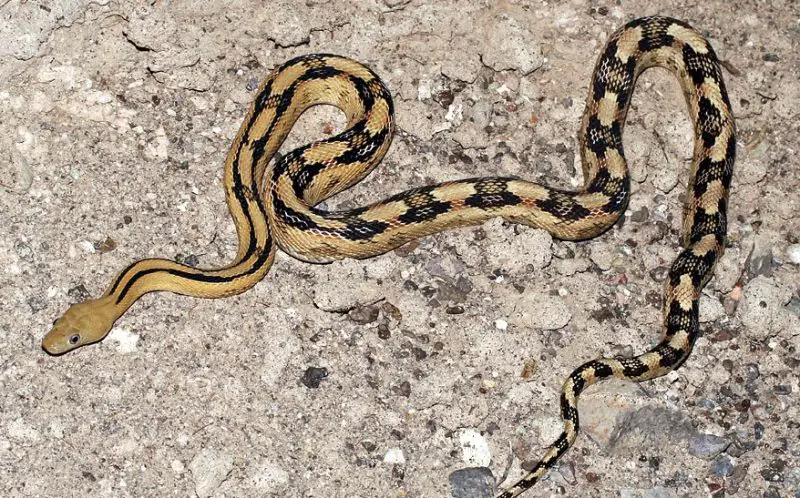
The Northern Trans-Pecos Rat Snake (Bogertophis subocularis subocularis), ideal for beginners, belongs to the Colubridae family. Known also as the Trans-Pecos Rat Snake or Davis Mountain Rat Snake, it reaches 36 to 54 inches and lives 10 to 15 years. Priced between $100 and $200, these snakes feature tan-orange, yellow, or light olive bodies with H-shaped brown blotches. They inhabit rocky outcrops, brushy slopes, and desert flats, feeding on lizards, birds, and rodents.
Red-tailed Green Ratsnake
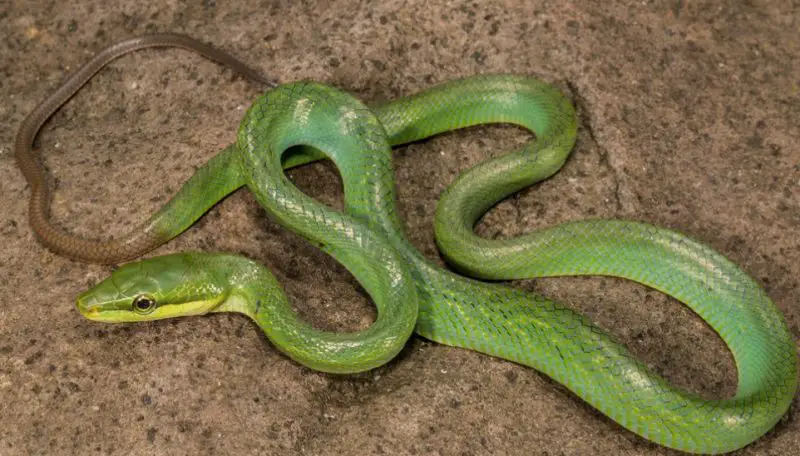
The Red-tailed Green Rat Snake (Gonyosoma oxycephalum), also known as the Arboreal Rat Snake or Red-tailed Racer, is an intermediate-level pet. Part of the Colubridae family, these snakes can grow almost 8 feet long and live up to 20 years. Priced between $150 and $300, they are predominantly green with black between the scales and bright blue tongues. Native to Southeast Asia, they inhabit tropical forests and primarily feed on bats, birds, and eggs.
Ringneck
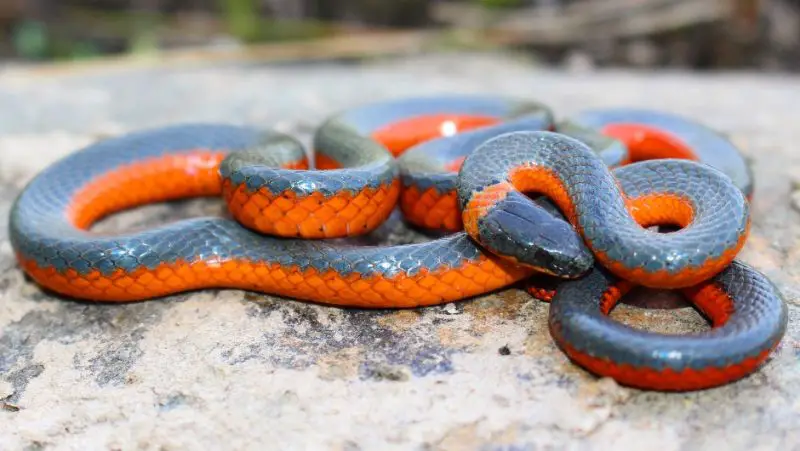
The Northern Ringneck Snake (Diadophis punctatus edwardsii), also known as the Ring-necked Snake, is suitable for intermediate keepers. Part of the Colubridae family, these snakes grow 10 to 15 inches and live up to 20 years in the wild and 6 years in captivity. With slender bodies and smooth scales, their colors range from black to olive with yellow, orange, or red undersides. Found in various habitats with ample cover, they feed on worms, mollusks, and amphibians.
Chihuahuan Hooknose Snake
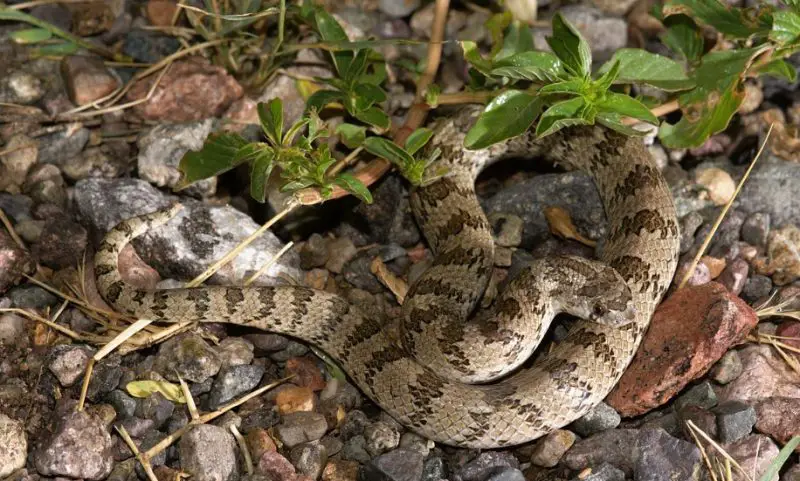
The Western Hooknose Snake (Gyalopion canum), also known as the Chihuahuan Snake or Hook-nosed Snake, belongs to the Colubridae family. Growing up to 15 inches, their lifespan is unknown. These nocturnal burrowers have gray or gray-brown bodies with dark brown blotches and smooth scales, and cream or pale yellow undersides. Notable for their upturned snout, they make clicking or tooting noises in defense. Found in sandy habitats near water, they primarily eat arthropods, smaller snakes, lizards, and reptile eggs.
Mexican Hog-nosed Snake
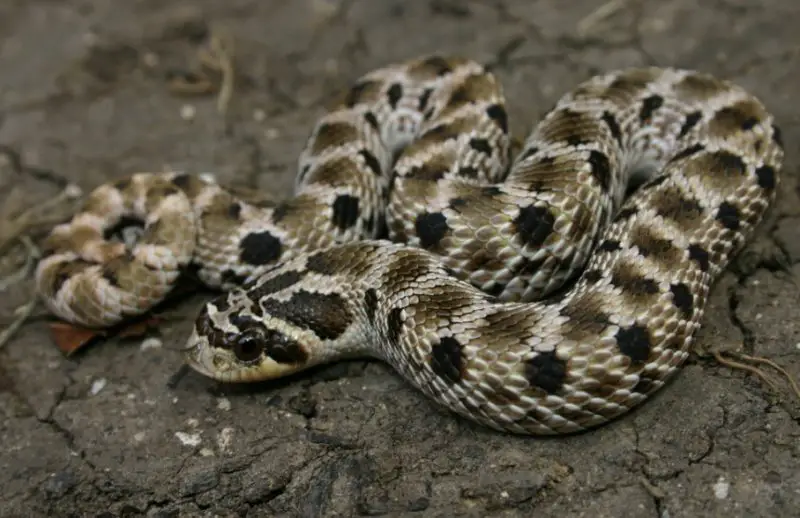
The Mexican Hog-nosed Snake (Heterodon kennerlyi), ideal for beginners, belongs to the Colubridae family. Known for their light tan or orange skin with blurry brown blotches turning into stripes near the tail, these snakes grow 17 to 24 inches and live 12 to 20 years. Priced between $100 and $500, they have black checkered undersides. Found in sandy habitats, they primarily feed on lizards and rodents but also consume frogs, being immune to their toxins.
Plains Hognose Snake
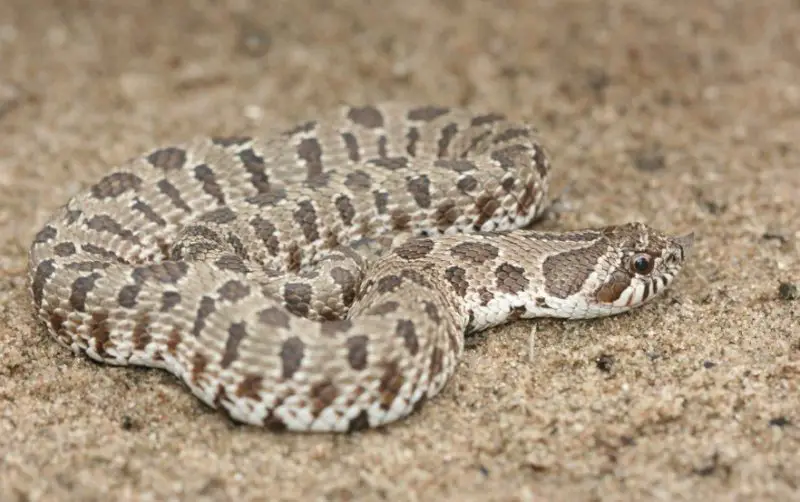
The Plains Hognose Snake (Heterodon nasicus nasicus), also known simply as the Hognose Snake, is perfect for beginner enthusiasts. Part of the Colubridae family, they reach 15 to 25 inches and live about 10 to 15 years. Priced between $100 and $500, these snakes have a cute, lovable face with a tiny snout. Typically light yellow or tan with brown spots, they thrive in dry terrariums with low vegetation and sandy areas for burrowing. They eat frogs, toads, lizards, mammals, insects, and salamanders.
Eastern Hognose Snake
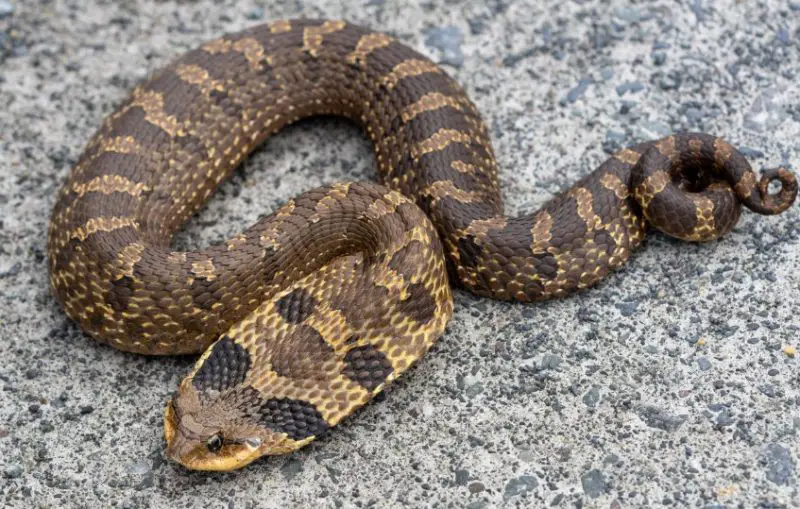
The Eastern Hognose Snake (Heterodon platirhinos), also known as the Eastern hog-nosed snake, is a top choice for beginner snake enthusiasts. Belonging to the Colubridae family, they reach 20 to 33 inches and live up to 12 years. Priced between $100 and $500, these snakes have a large, round head with an upturned snout. Their coloration varies from dark gray or olive-green to yellow, tan, or light brown, with dark brown spots.
Found in sandy woodlands, farmland, and coastal areas, they feed on frogs, salamanders, invertebrates, birds, and small mammals. Their hog-like nose aids in burrowing for prey.
Texas Nightsnake
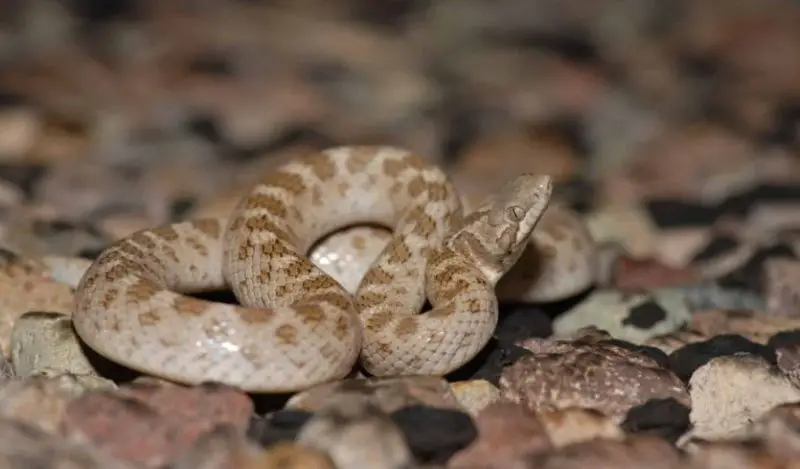
The Texas Nightsnake (Hypsiglena jani texana), also known as the Chihuahuan Night Snake, is suited for intermediate handlers. Part of the Colubridae family, they grow up to 26 inches and live around 12 years in captivity. Identified by their tan or light gray color with dark brown or gray blotches, they have smooth dorsal scales and unmarked undersides. With copper eyes and vertically elliptical pupils, they inhabit semi-arid areas with rocky soil, feeding on smaller snakes and soft insects.
Gray-Banded Kingsnake
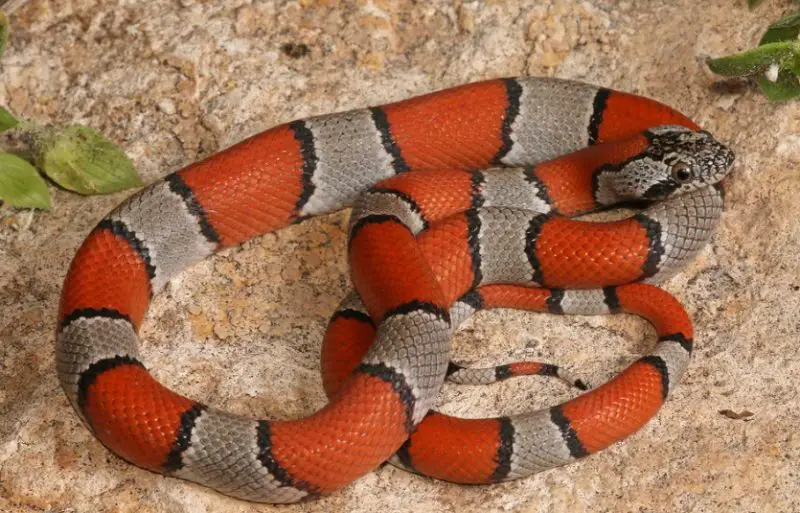
The Gray-Banded Kingsnake (Lampropeltis alterna), also known as the Alterna or Davis Mountain Kingsnake, is perfect for beginner enthusiasts. Belonging to the Colubridae family, they reach 12 to 40 inches and live about 20 years. With a striking appearance of gray bodies adorned with alternating orange blotches outlined in black, they appear striped.
Found in hot, arid habitats, particularly rocky or mountainous areas, they hide in the ground or rocky crevices to cool off. Their diet primarily consists of lizards but may also include frogs, small rodents, other snakes, and ground-nesting bird eggs.
California Kingsnake
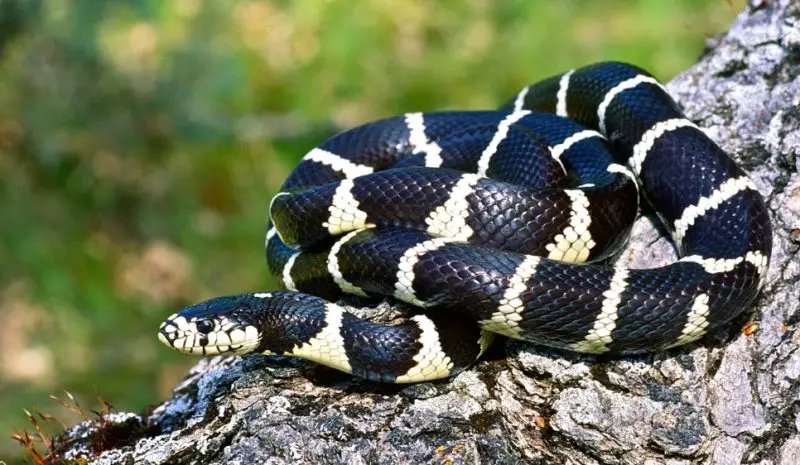
California Kingsnakes (Lampropeltis getula californiae) are ideal for beginner keepers, belonging to the Colubridae family. They grow 3 to 4 feet long and can live 20 to 30 years. Priced around $100, some morphs may cost up to $200. Typically black or dark brown with white or pale yellow bands, they appear striped.
Found in various habitats, they feed primarily on rodents but also eat small birds, lizards, and other snakes, including rattlesnakes. These docile snakes are commonly kept as pets due to their manageable size and temperament.
Desert Kingsnake
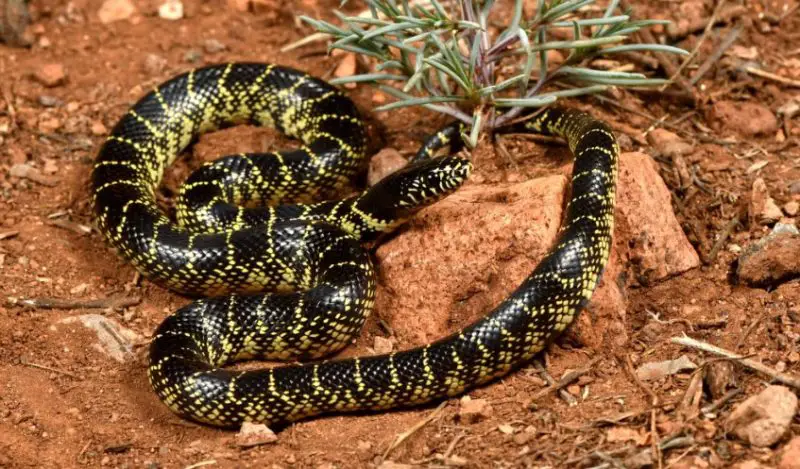
The Desert Kingsnake (Lampropeltis getula splendida), also known as the Desert King Snake, is suitable for beginner keepers in the Colubridae family. Growing up to 5 feet long, they have a lifespan of 12 to 20 years and are priced between $100 and $200.
Sporting black or dark brown with yellow or white speckles on their sides and larger black blotches on their backs, they prefer open areas like abandoned farms, grasslands, deserts, woodlands, and low mountains. Their diet includes rodents, lizards, and even smaller snakes, including rattlesnakes if encountered.
Arizona Mountain Kingsnake
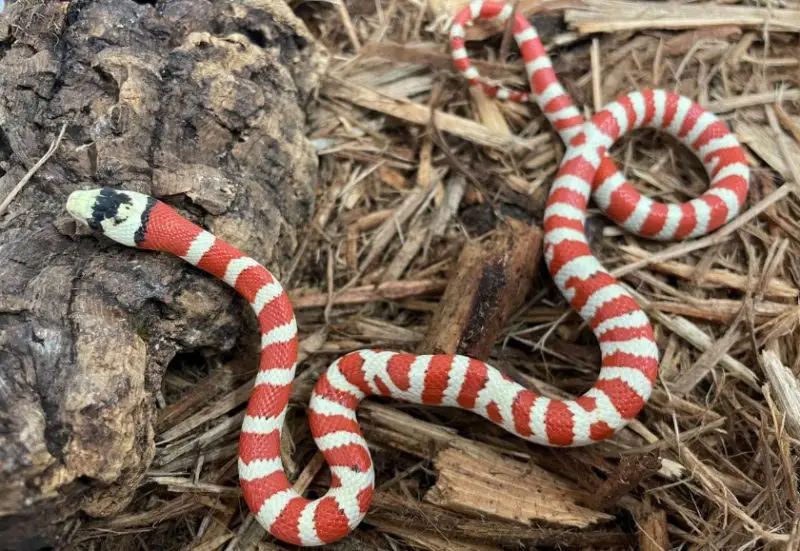
The Arizona Mountain Kingsnake (Lampropeltis pyromelana pyromelana), also known as the Sonoran Mountain Kingsnake, is recommended for beginner enthusiasts in the Colubridae family. Growing up to 36 inches, they can live up to 30 years in captivity and 10 to 15 years in the wild. Priced between $100 and $200, they are typically red or dark orange with cream blotches outlined in black, resembling stripes.
Found in rocky areas near streams in higher mountain elevations, they primarily eat lizards, rodents, and the eggs of other animals. If startled, they emit a foul-smelling musk for self-defense.
New Mexico Milksnake
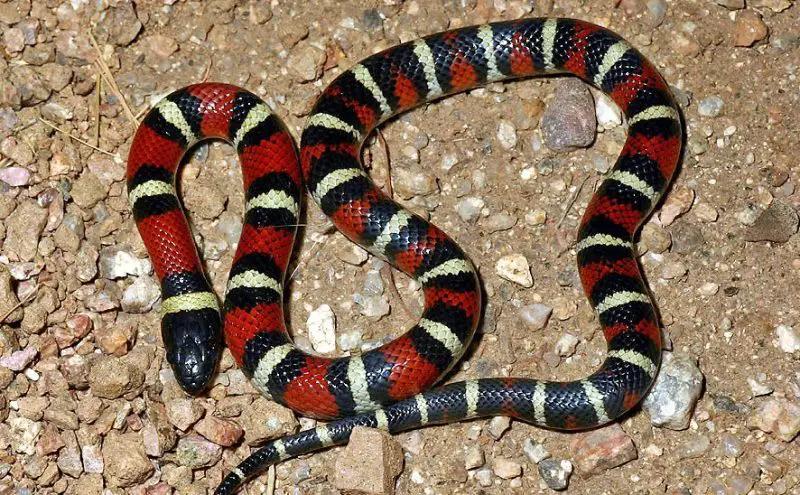
The New Mexico Milksnake (Lampropeltis triangulum celaenops), also known simply as the Milksnake, is perfect for beginner enthusiasts within the Colubridae family. They grow 24 to 42 inches long and live around 20 years in captivity, or about 12 years in the wild. Typically tan or brown with black-brown bands and blotches, their skin may exhibit a pale yellow hue with red stripes, resembling the venomous Coral snake.
Found in open grasslands and prairies, they are nocturnal and feed on smaller mammals, lizards, other snakes, and reptile eggs, usually hiding under logs or burrows.
Plain-bellied Water Snake
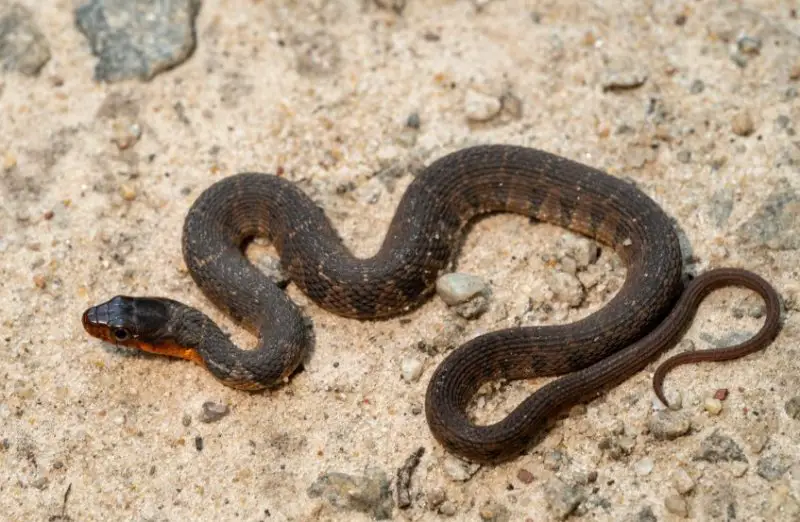
The Plain-Bellied Water Snake (Nerodia erythrogaster), also known as the Plainbelly Water Snake or Blotched Snake, is suitable for beginner keepers within the Colubridae family. Growing 30 to 48 inches long, they can live up to 10 years in captivity, with an unknown wild lifespan. Priced between $20 and $80, they come in various colors, including green-gray, solid gray, brown, olive green, or black.
Distinguished by their unmarked underside, typically pale yellow or red, they inhabit forest edges, ponds, lakes, streams, and bays, feeding on fish, crayfish, tadpoles, amphibians, and salamanders.
Smooth Green Snake
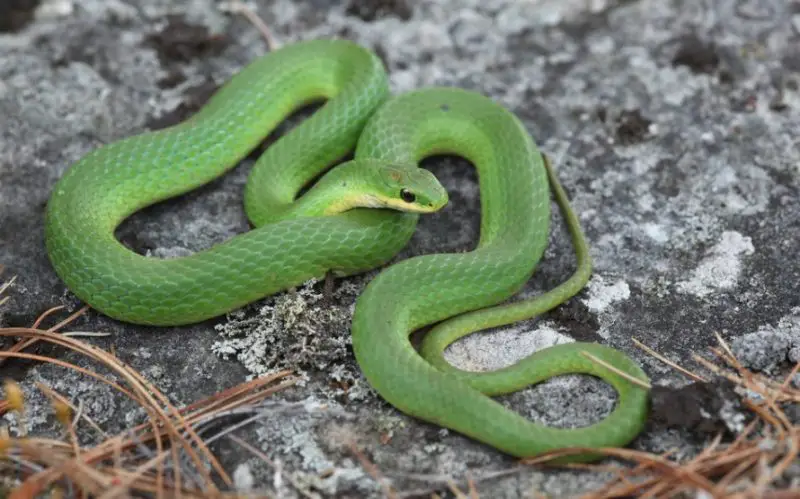
The Smooth Green Snake (Opheodrys vernalis), also known simply as the Green Snake, is recommended for intermediate keepers within the Colubridae family. Growing 14 to 20 inches long, they have a lifespan of 6 years and are priced between $8 and $10. They are ideal for owners who prefer feeding insects over rodents, consuming spiders, moths, ants, snails, slugs, worms, and caterpillars. Timid by nature, they may not be suitable for frequent handling but are harmless.
Found in open woods, stream edges, marshes, and meadows, they prefer moist, grassy areas. Sporting bright green coloration, they may have a pale yellow underside and are relatively small, with beady eyes. However, they can be challenging to keep in captivity due to their anxious and easily stressed nature.
Great Plains Rat Snake
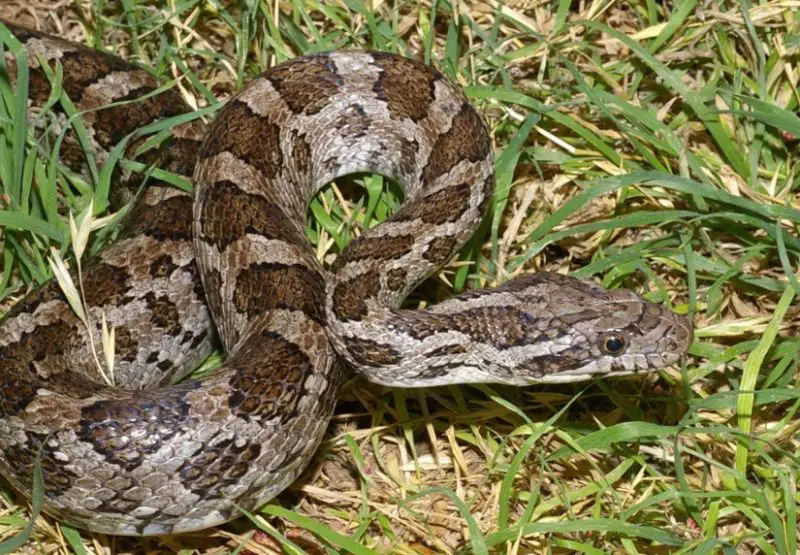
The Great Plains Ratsnake (Pantherophis emoryi) is a suitable choice for beginner keepers within the Colubridae family. Growing up to 5 feet long and living for 21 years, they are priced between $50 and $100. Typically tan or light gray with brown, dark gray, or greenish-gray blotches down their back and a light tan stripe on each side of their head, they prefer habitats such as brushes, prairies, fields, canyons, woodlands, and riparian areas.
Non-venomous but occasionally bitey, they primarily feed on rodents but also consume lizards, frogs, and birds, using ambush tactics to catch their prey.
Northern Green Rat Snake
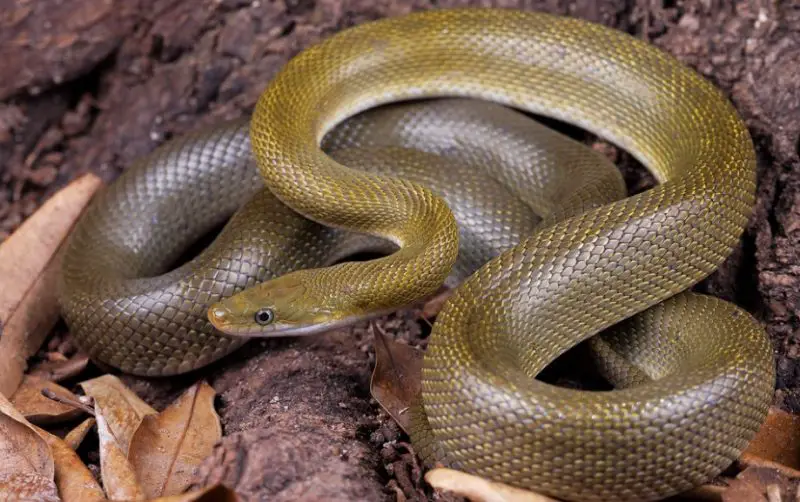
The Northern Green Ratsnake (Senticolis triaspis intermedia), also known simply as the Northern Green Ratsnake, is recommended for beginner keepers within the Colubridae family. Growing up to 63 inches (5.25 feet) long and living for 12 to 20 years, they exhibit an olive-green color with a slight lime green tint, while their undersides are cream-colored. Occasionally adorned with dark mustard yellow markings or blotches, they are mostly faded.
Found in grasslands and evergreen forests, they primarily feed on small birds, lizards, and bats, using constriction as their method of predation.
Gophersnake
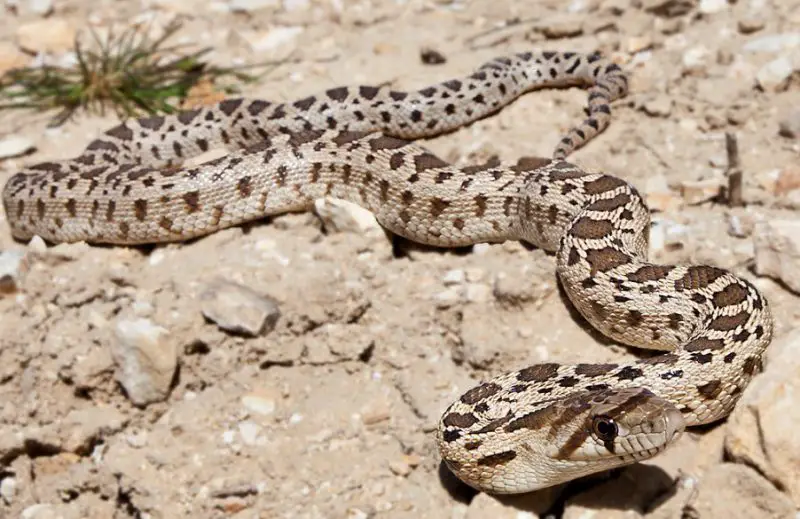
The Gopher Snake (Pituophis catenifer), also known as the Gopher Snake, is suited for intermediate keepers within the Colubridae family. Ranging from 4 to 7 feet and occasionally reaching up to 9 feet, they have a lifespan of 12 to 15 years in the wild, but can live up to 30 years in captivity. Priced between $30 and $100, they are heavy-bodied and docile, though can become defensive when threatened.
They require a secure enclosure due to their escape artist tendencies, and they also need ample space due to their size and active nature. Typically light tan to brown with large, dark brown spots and lined patterns, they inhabit pine or oak barrens, savannas, and sand prairies, where they help control gopher populations by feeding on small rodents.
Long-nosed Snake
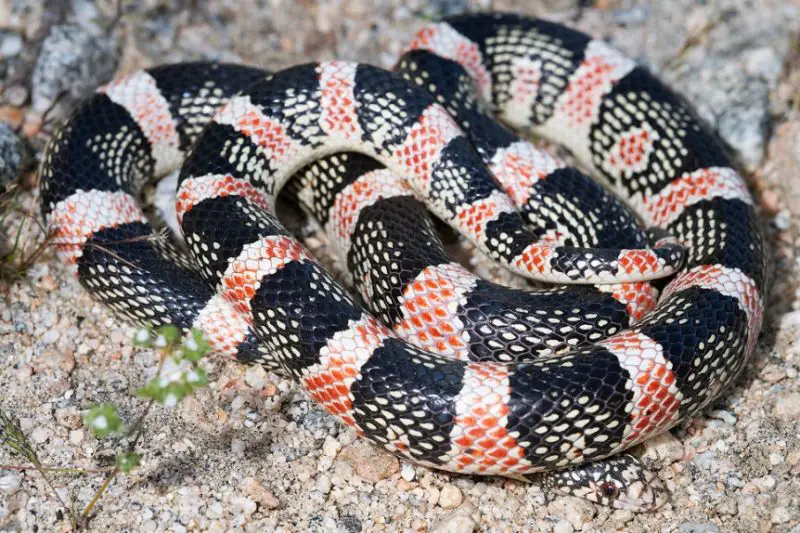
The Long-nosed Snake (Rhinocheilus lecontei), also known as the Long-nosed Snake, is recommended for expert keepers within the Colubridae family. Growing 30 to 40 inches long, they have a lifespan of less than 20 years. Notoriously adept at escaping, they are challenging to keep. Sporting a slightly upturned, long snout, they feature a black and red-orange stripe-like pattern, often resembling Coral Snakes or Milk Snakes.
Nocturnal by nature, they prefer arid environments, feeding primarily on amphibians and lizards, with occasional consumption of smaller snakes and rodents.
Sonoran Whipsnake
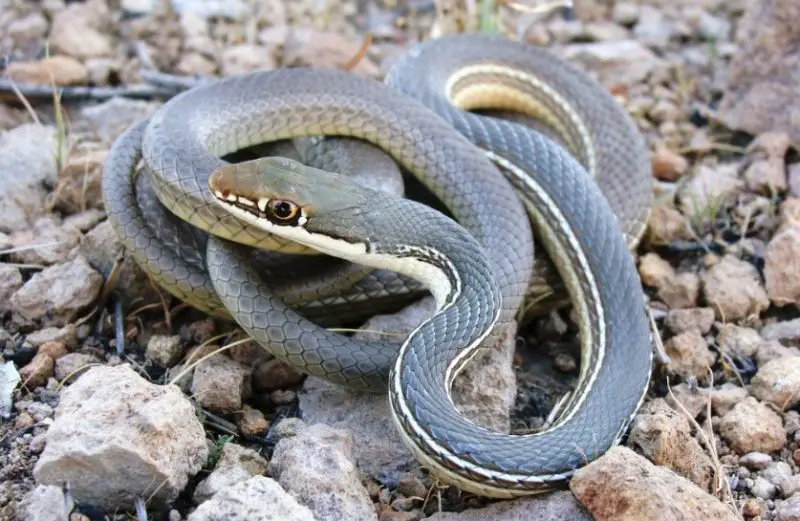
The Sonoran Whipsnake (Masticophis bilineatus), also known as the Sonoran Mountain Whipsnake, is suited for expert handlers. Belonging to the Colubridae family, they reach up to 6 feet and live about 15 years. These aggressive snakes have slender olive or gray-blue bodies that turn yellow towards the tail and feature light stripes on the sides. They inhabit foothills, rocky canyons, and forests at elevations of 2,000 to 6,000 feet, feeding on lizards and birds, particularly nestlings.
Coachwhip
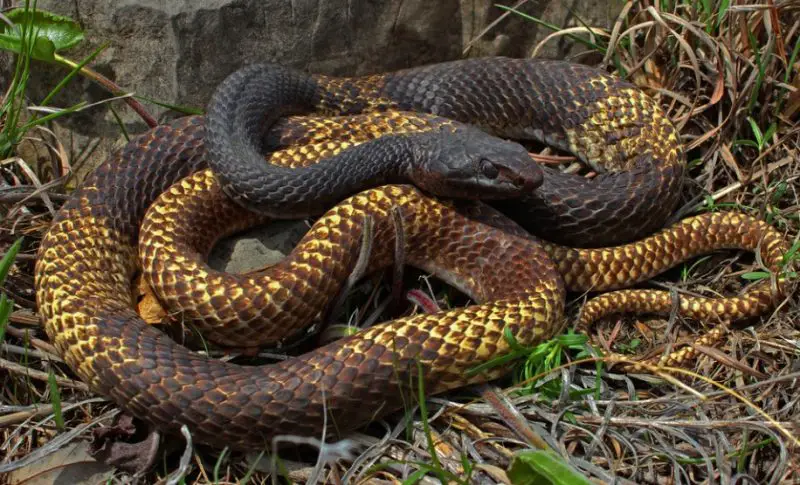
The Eastern Coachwhip (Coluber flagellum flagellum), also known as the Whipsnake, is suited for expert keepers. These Colubridae family members reach 5 to 8 feet and live 16 to 20 years in captivity. Priced around $50, Coachwhips are among the fastest and longest snakes in America. They have slender bodies with dark heads fading to lighter browns and tans. Found in dry terrains like prairies, deserts, and shrublands, they eat rodents, frogs, lizards, birds, eggs, spiders, and small snakes.
Chihuahuan Lyre Snake
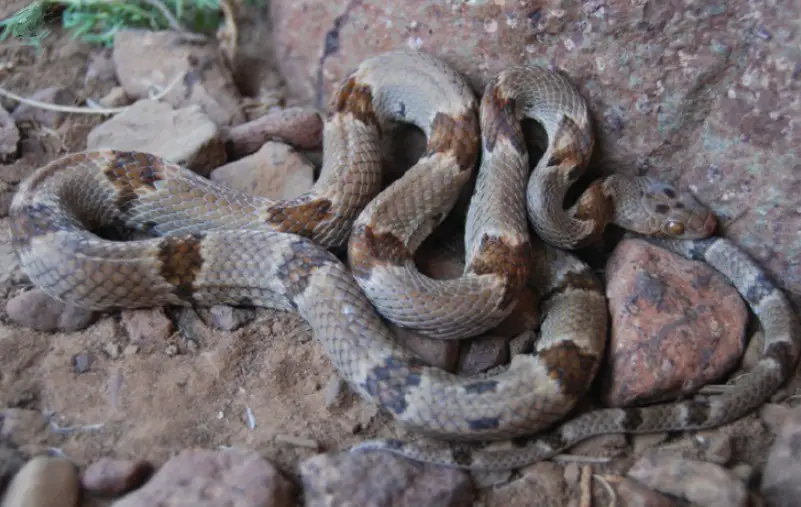
The Chihuahuan Lyre Snake (Trimorphodon vilkinsonii), also known as the Texas Lyre Snake, is suitable for intermediate keepers. Growing up to 30 inches, they live around 5 years.
With a tan, brown, or gray body featuring dark-outlined brown blotches, these snakes thrive in rocky, desert climates. Feisty and adept escape artists, they primarily feed on whiptail lizards, using mild venom to subdue their prey.
Slender Blind Snake
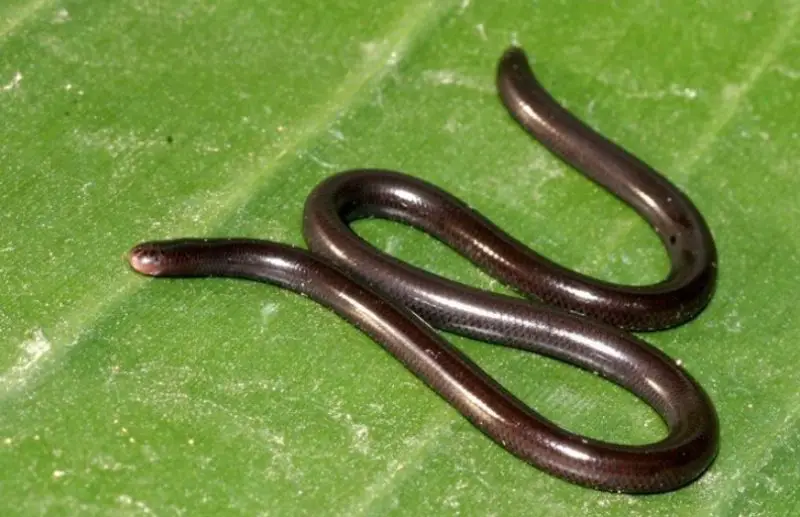
The Slender Blind Snake (Leptotyphlopidae), also known as the Threadsnake, is suitable for intermediate keepers due to its secretive nature and specific care needs. These nocturnal snakes, resembling earthworms, range from 4 to 10 inches and come in colors like pink, tan, brown, black, and gray.
Preferring to live underground, they frequent ant burrows and termite hills, feeding on insects, eggs, pupae, and larvae.
New Mexico Blind Snake
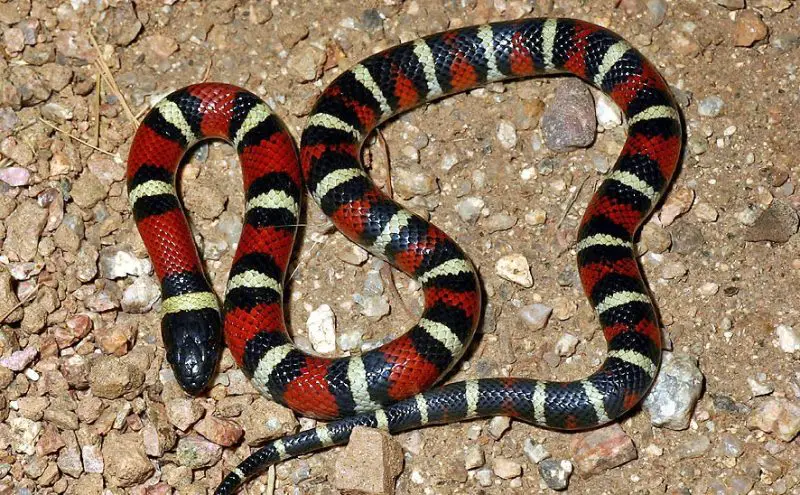
The New Mexico Thread Snake (Leptotyphlops dissectus), also known as the New Mexico Threadsnake, is ideal for intermediate keepers due to its secretive nature. These nocturnal, underground dwellers grow 5 to 10 inches long and resemble worms with their pink or tan color and tiny black eyes.
Found in prairies, deserts, and stony hillsides, they frequent ant burrows and termite hills, feeding on insects, eggs, pupae, and larvae.
Trans-Pecos Blind Snake
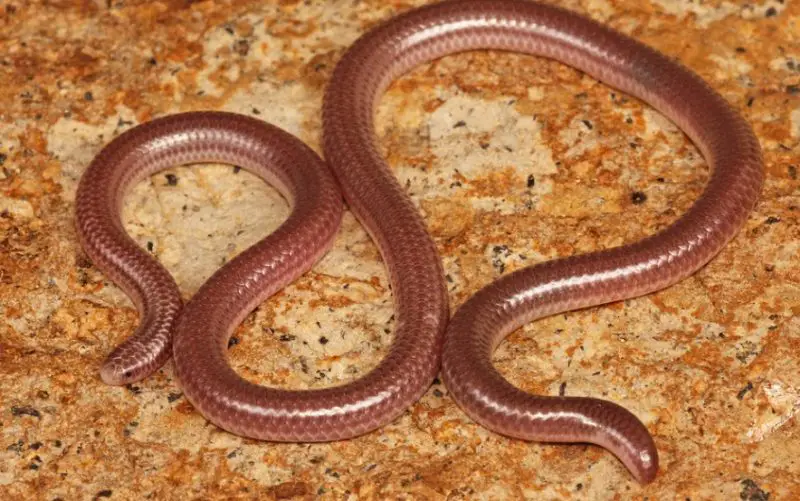
The Trans-Pecos Blind Snake (Leptotyphlops humilis segregus), also known as the Western Blind Snake, is suitable for intermediate keepers. These 7 to 10-inch snakes resemble shiny earthworms and come in colors like pink, tan, brown, black, and gray.
They live up to 66 feet underground in desert or scrub areas with loose soil. Frequenting ant burrows and termite hills, they feed on insects, eggs, pupae, and larvae.
Lined Snake
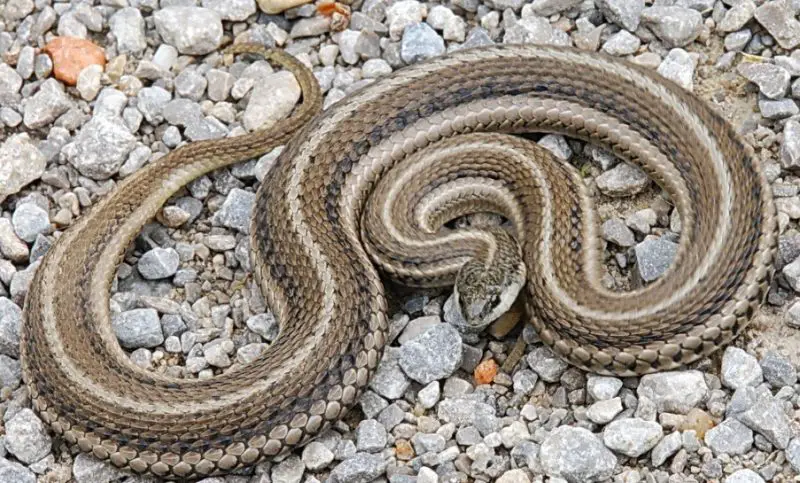
The Lined Snake (Tropidoclonion lineatum) is suitable for intermediate keepers. These 8 to 12-inch snakes live 3 to 10 years and resemble mini Garter Snakes, with brown or gray-brown bodies and dark stripes. Nocturnal and often found in urban areas, they inhabit parks, grassy areas, and woodland passages.
They hide under leaf litter, rocks, or burrow in soil. When disturbed, they emit a musk but rarely bite. Their undersides are cream-colored with gray blotches.
Desert Striped Whipsnake
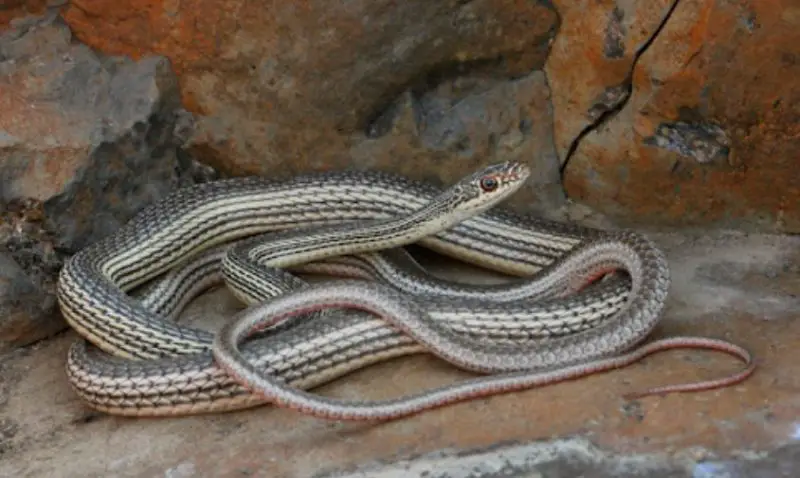
The Desert Striped Whipsnake (Coluber Masticophis taeniatus taeniatus), also known as the Striped Whipsnake, is ideal for expert handlers. Belonging to the Colubridae family, they range from 24 to 67 inches and live 10 to 20 years. Typically black, dark brown, or gray with blue or olive tints, they have two pale yellow stripes along their length and pale yellow undersides fading to coral red. Found in grasslands, canyons, and rocky streams, they eat mammals, birds, eggs, amphibians, snakes, and insects.
Mountain Patchnose Snake
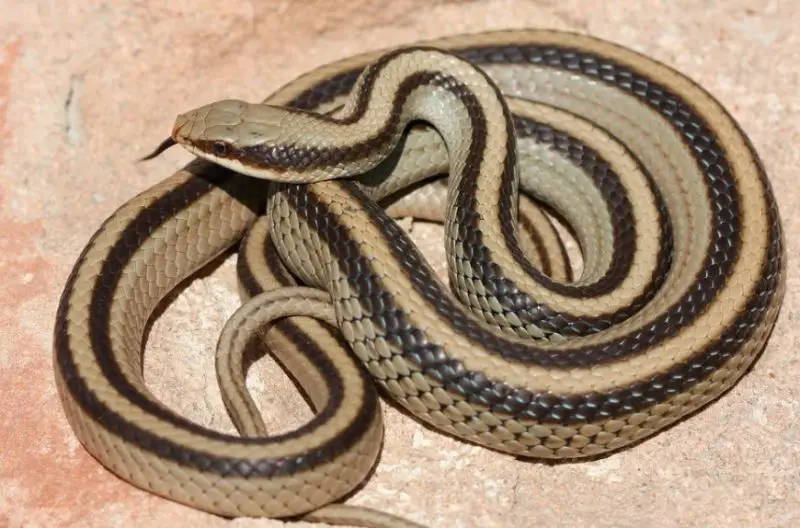
The Mountain Patchnose Snake (Salvadora grahamiae grahamiae), also known as the Patch-nosed Snake, is suitable for beginner keepers within the Colubridae family. Typically less than 4 feet in length and with a lifespan of 14 years, they are priced between $50 and $100. Sporting a long, slender body, they are tan or cream-colored with two wide black or dark brown stripes along their back.
Active during the day, they swiftly navigate open arid or semi-arid habitats like grasslands, deserts, and rocky hillsides. Their diet consists of whiptails, other lizards, small mammals, smaller snakes, amphibians, birds, and reptile eggs.
Ground Snake
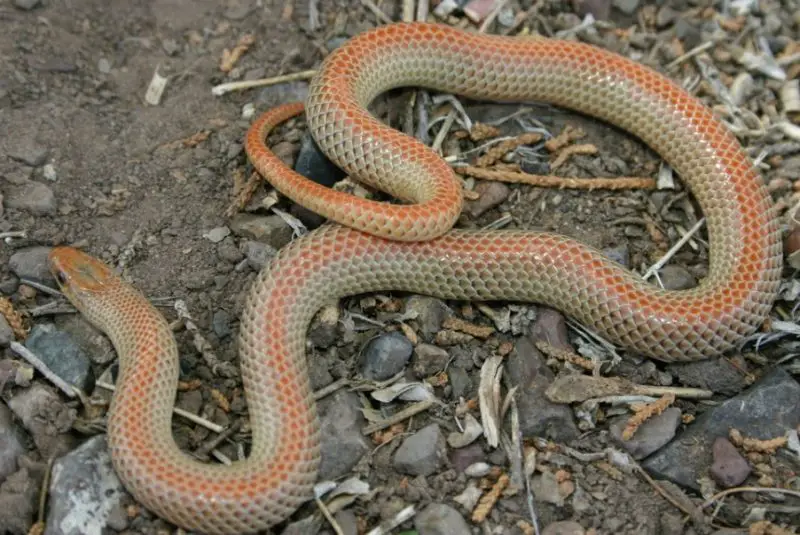
The Variable Ground Snake (Sonora semiannulata), also known as the Western Ground Snake or Common Ground Snake, is suitable for beginner enthusiasts in the Colubridae family. Ranging from 8 to 19 inches, they boast a lifespan of around 15 years. Their coloration varies; some are brown, red, or orange with black banding and blotches resembling stripes.
Preferring arid environments with sandy or rocky terrain, they feed on invertebrates like spiders, centipedes, crickets, and scorpions. These elusive snakes are typically found hiding in debris but may emerge at dusk.
Smith’s Black-headed Snake
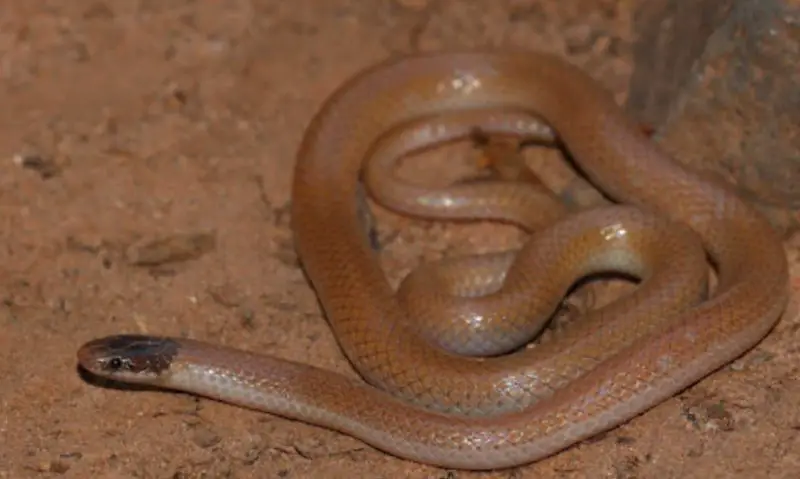
The Smith’s Black-headed Snake (Tantilla hobartsmithi), also known as the Southwestern Blackhead Snake, is an intermediate-level choice for Colubridae enthusiasts. With an adult size of 8 inches and an unknown lifespan, they sport a light brown or tan body with a distinctive black head. Their lavender-colored undersides feature a striking red line down the middle.
These snakes thrive in desert scrub areas, semi-desert grasslands, and woodlands, where they prey on caterpillars, centipedes, and beetle larvae.
Plains Black-headed Snake
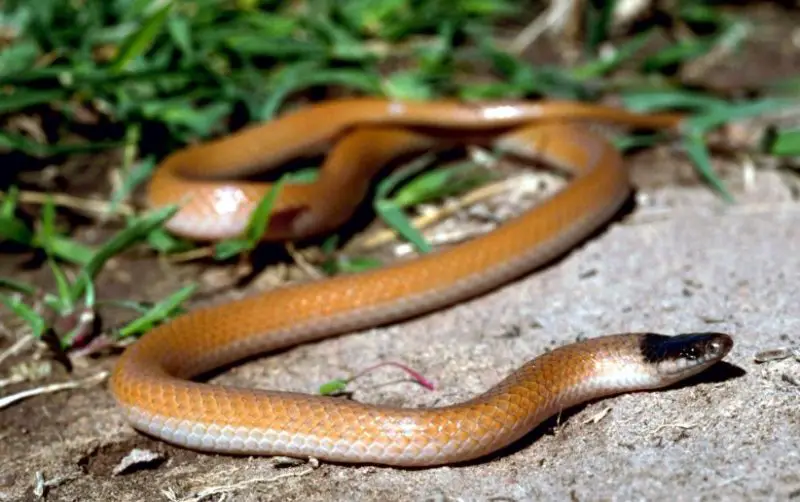
The Plains Black-headed Snake (Tantilla nigriceps), also known as the Plains Blackhead Snake, suits intermediate-level enthusiasts. Typically measuring 7 to 15 inches with an unknown lifespan, they boast a uniform tan to grayish-brown body with a pink-orange underside. Their defining feature is a large black or dark blue head.
Found in grassy, rocky prairies, and hillsides, they prey on spiders, beetle larvae, and occasionally scorpions. They may also venture into human habitats, like basements.
Western Blackneck Garter Snake
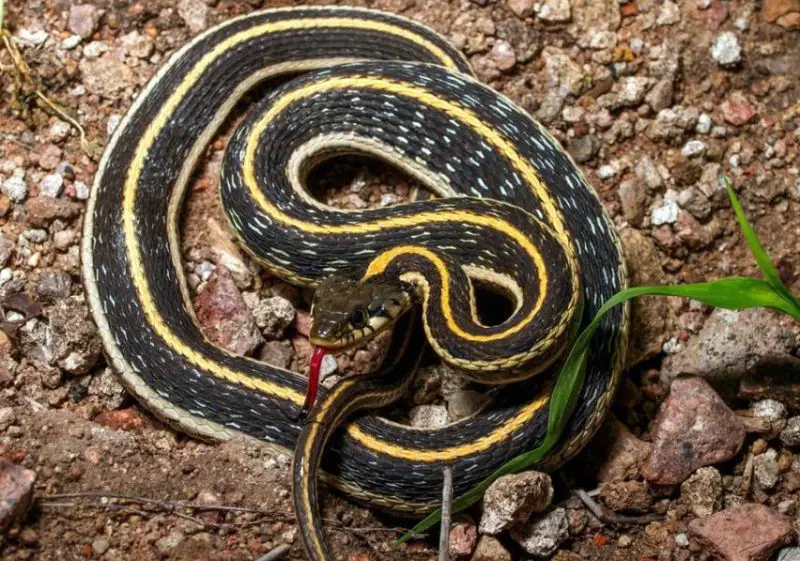
The Western Blackneck Garter Snake (Thamnophis cyrtopsis cyrtopsis), also known as the Black-necked Gartersnake, suits beginners. Typically reaching 42 inches in length, they have a lifespan of 10 years in captivity and 4 to 5 in the wild, with an average price range of $50 to $100.
Active during the day, they thrive in diverse habitats and temperatures. With a preference for water sources, they often dwell near rivers, preying on amphibians, small fish, and invertebrates.
Wandering Garter Snake
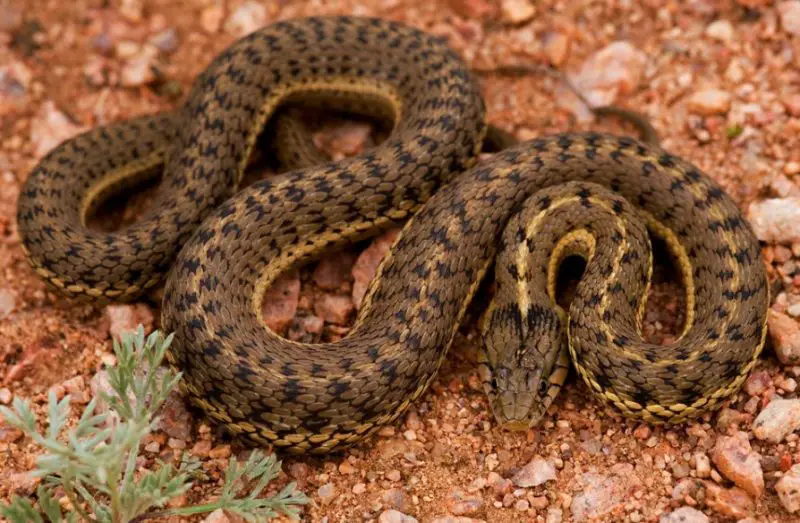
The Wandering Garter Snake (Thamnophis elegans vagrans), also known as the Western Terrestrial Garter Snake, suits beginners. Typically ranging from 18 to 43 inches, they have a lifespan of 6 to 12 years in captivity and 2 years in the wild. They feature a gray or gray-brown hue with a black checkered pattern and three cream-colored stripes.
Thriving in moist climates, they inhabit riparian areas, lakes, ponds, wet meadows, sagebrush, and coniferous forests, preying on fish, mollusks, tadpoles, amphibians, insects, and small vertebrates.
Checkered Gartersnake
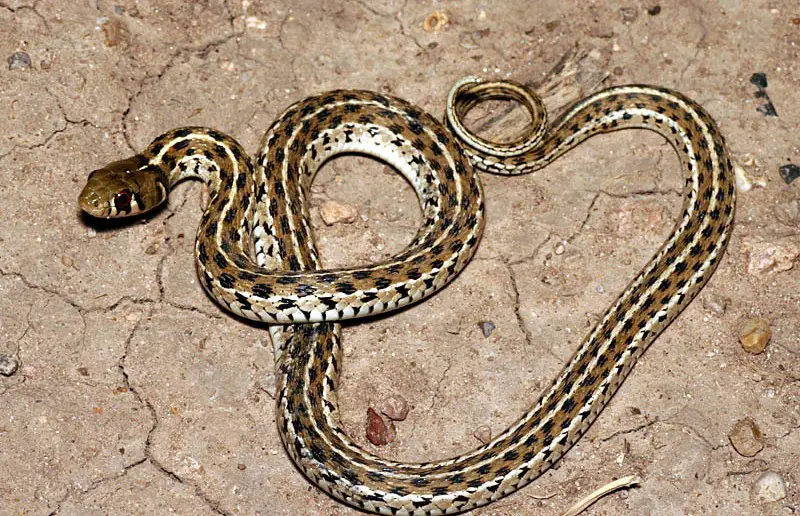
The Checkered Garter Snake (Thamnophis marcianus marcianus) is an excellent choice for beginners. With an adult size of 2 feet and a lifespan of 4 to 5 years in the wild (10 years in captivity), they are manageable pets.
Sporting an olive green or brown-green coloration with a distinct checkerboard pattern on their sides and a pale yellow or tan stripe down their back, they thrive in arid and semi-arid habitats like savannas, deserts, and forests. Their diet includes earthworms, slugs, leeches, amphibians, frog eggs, and rodents.
Narrow-Headed Garter Snake
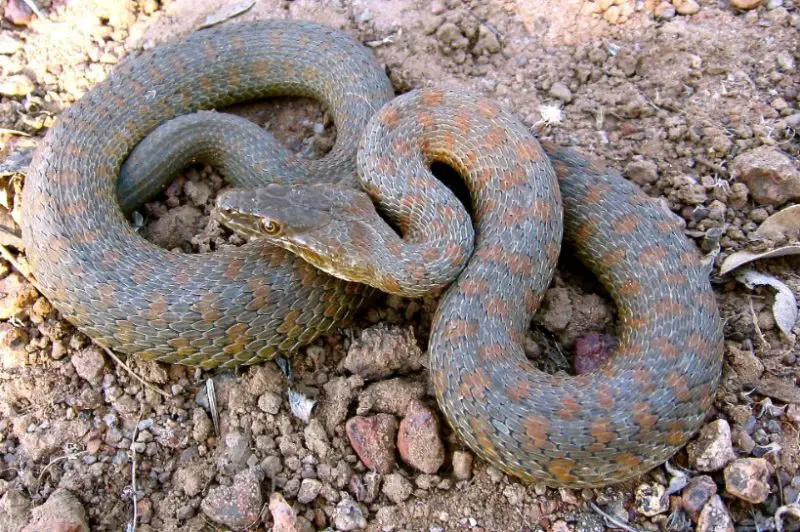
The Juvenile Narrow-Headed Garter Snake (Thamnophis rufipunctatus) presents a captivating sight from the Gila River, Catron Co, NM. From Pierson Hill, this beginner-friendly snake species boasts an adult size of 44 inches and a lifespan of 4 to 5 years in the wild (10 years in captivity).
Sporting a brown-gray or dark tan coloration with faded brown markings resembling round blotches in a checkerboard pattern, they thrive in aquatic environments, preferring cool, clear water sources like rivers and streams. They exhibit remarkable swimming abilities, navigating strong currents to hunt for fish.
Arid Land Ribbon Snake
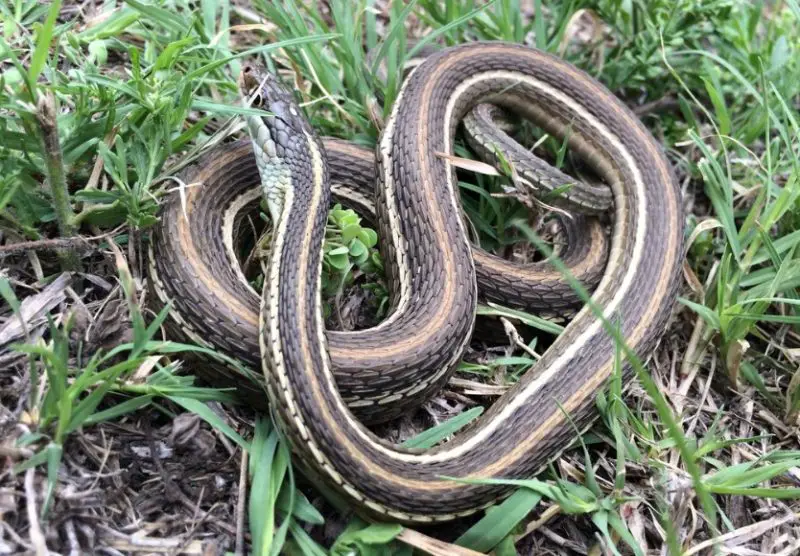
The Arid Land Ribbon Snake (Thamnophis proximus diabolicus) is a species thriving in harsh desert landscapes. With its slender form and graceful movement, it adapts adeptly to arid conditions. Typically measuring around 20 to 30 inches, it displays an intricate pattern of light and dark stripes running along its body.
These snakes are often found in sandy habitats, seeking refuge among desert shrubs and rock formations. Their diet mainly consists of small amphibians and insects, sustaining them in their arid environment.
Plains Garter Snake
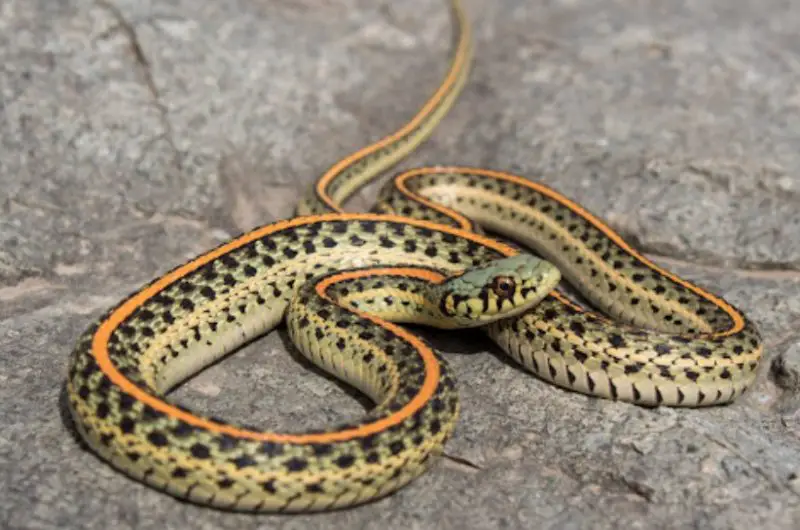
The Plains Garter Snake (Thamnophis radix) belongs to the Colubridae family and is ideal for beginners. They are friendly, non-venomous, and small, reaching 16 to 28 inches. Priced between $20 to $300, these snakes live up to 8 years.
With a black body and a yellow or orange stripe, they thrive in moist, grassy areas near streams and lakes. Their diet includes amphibians, worms, fish, eggs, and rodents.
Sonoran Lyre Snake
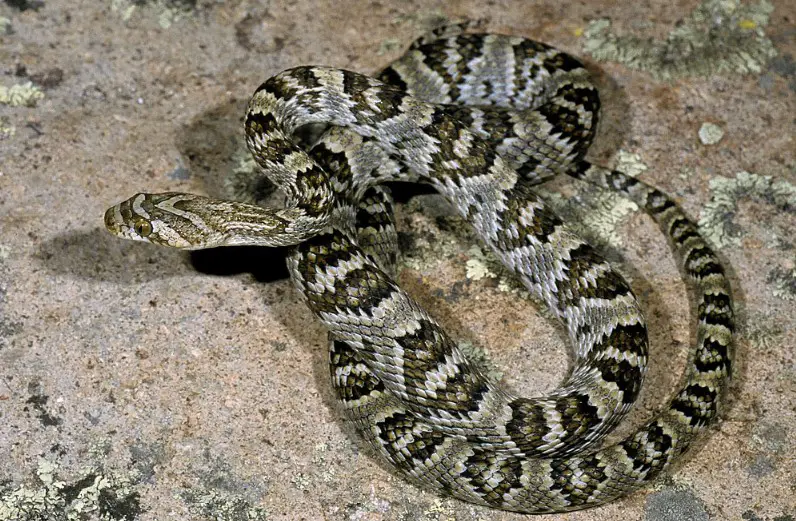
The Sonoran Lyre Snake (Trimorphodon lambda) is ideal for intermediate keepers due to its feisty nature and escape artistry. Growing up to 4 feet, these nocturnal snakes live about 5.3 years and cost between $150 to $200.
Native to rocky habitats, they have a gray to light brown coloration with tan or brown blotches. They primarily eat lizards but also consume small mammals, birds, bats, and other snakes.
Venomous Snake Species in New Mexico
Massasauga Rattlesnake
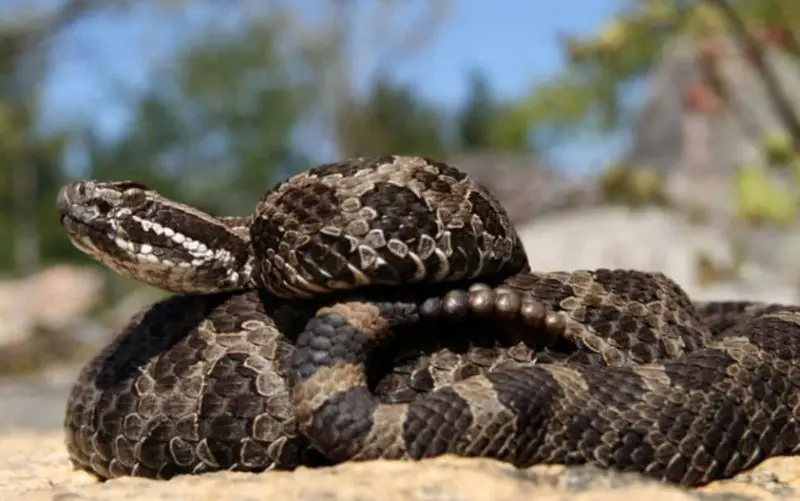
The Eastern Massasauga Rattlesnake (Sistrurus catenatus), also known as the Massasauga Rattlesnake, requires expert handling and is protected under the Endangered Species Act. Found mainly in Wisconsin and Ontario, they’re one of the most venomous snakes in the U.S., though they’re shy and bites are rare.
Tan or gray with brown blotches, they inhabit rocky areas, deserts, forests, prairies, and marshes, preying on insects, lizards, smaller snakes, and mammals. With heat-sensitive pits, they stalk prey before injecting venom and swallowing them whole.
Prairie Rattlesnake
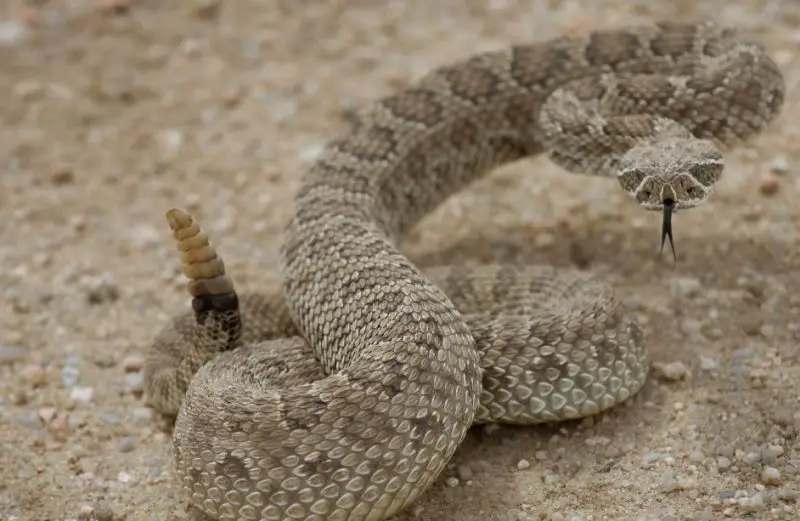
The Prairie Rattlesnake (Crotalus viridis), also known as the Western or Great Plains Rattlesnake, requires expert handling. At 5 feet long and with a lifespan of 16 to 20 years in the wild (up to 24 in captivity), they are potent pit vipers.
Tan with dark brown blotches or bands, their venom can be fatal if untreated. Found in sagebrush, grasslands, and rocky ledges, they primarily prey on rodents. Prices range from $100 to $200 per snake.
New Mexico Ridge-Nosed Rattlesnake
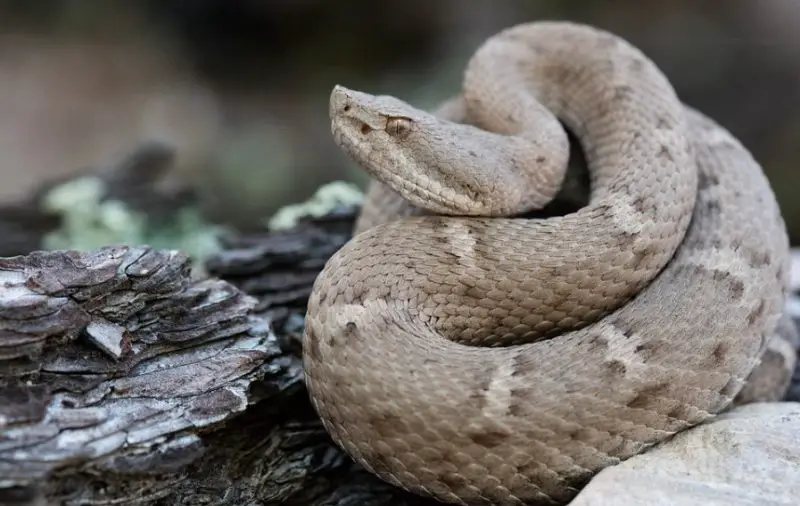
The New Mexico Ridge-Nosed Rattlesnake (Crotalus willardi obscurus), also known as the Ridge-Nosed Rattlesnake, is reserved for expert handlers. At 2 feet long with a 15-year lifespan, it’s the only venomous snake listed as a “Threatened Species” by the U.S. Fish and Wildlife Service.
Typically gray-brown with white or tan stripes, they have inconsistent brown blotches and a prominent ridge on their snout. Found in rocky canyons and forests, they feed on rodents, lizards, birds, and centipedes.
Western Diamondback Rattlesnake
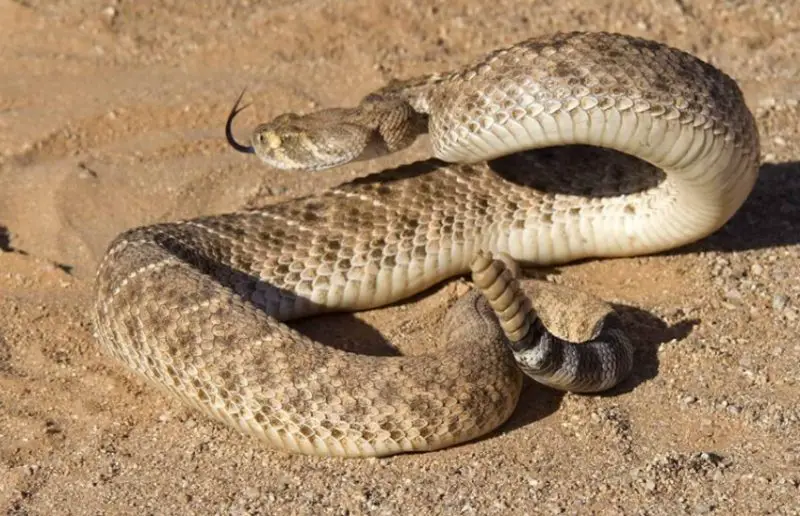
The Western Diamondback Rattlesnake (Crotalus atrox), also known as the Texas Diamondback Rattlesnake, is suited for expert keepers. Reaching up to 5 feet, they live 15 to 20 years. These snakes are dusty gray or brown, sometimes with pink, yellow, or white hues, and dark dorsal blotches.
With a triangular head and rattle-tipped tail, they inhabit diverse environments like grassy plains, deserts, and forests. Their diet includes small mammals such as prairie dogs, gophers, and birds.
Arizona Black Rattlesnake
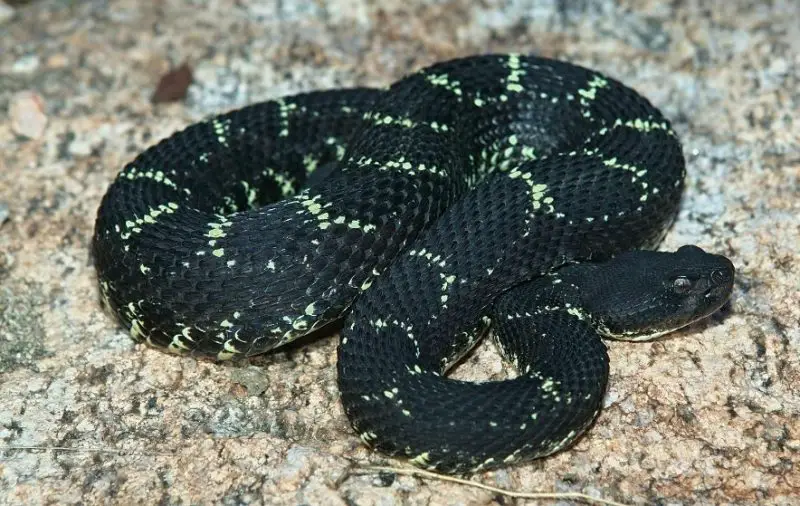
The Arizona Black Rattlesnake (Crotalus cerberus), also known as the Black Rattlesnake, is for expert keepers. These snakes reach 31 to 43 inches and live around 12.5 years in captivity. They are often entirely black, though some exhibit a dark brown or gray with darker blotches.
Preferring chaparral and pine-oak woodlands, their diet includes birds, mammals, and lizards. Their lifespan in the wild is unknown.
Banded Rock Rattlesnake
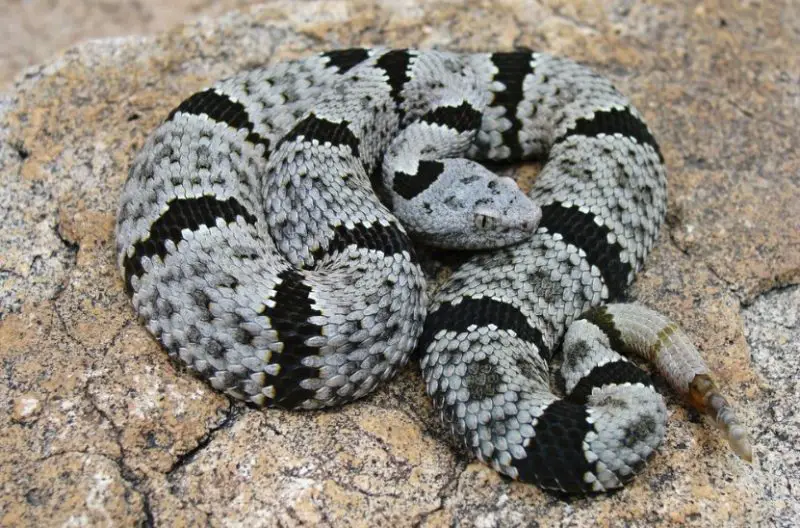
The Banded Rattlesnake (Crotalus lepidus klauberi), also known as the Green Rattlesnake or Green Rock Rattlesnake, is for expert keepers. These 24-inch snakes can live up to 30 years in captivity.
Typically light gray, green, or purple with dark gray bands, they inhabit arid and semi-arid environments like tropical deciduous forests and rocky flats. Their diet includes invertebrates, small mammals, lizards, birds, and other snakes, using venom to subdue prey. Their wild lifespan is unknown.
Black-tailed Rattlesnake
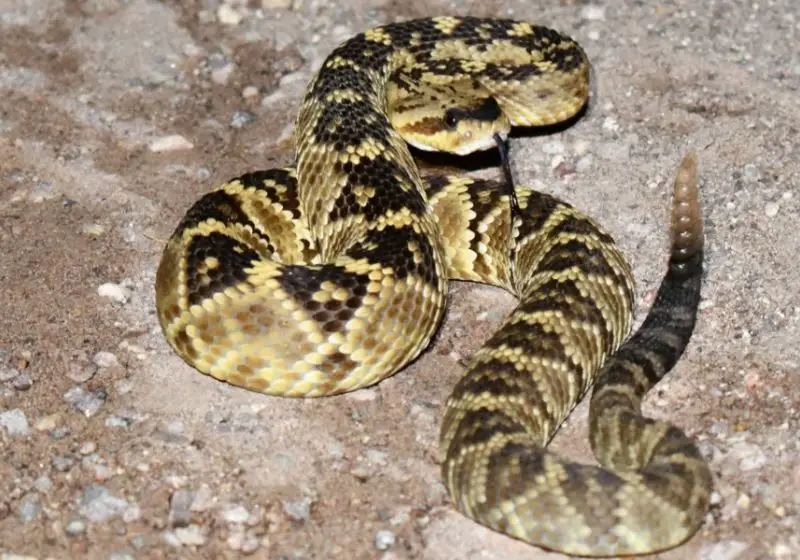
The Black-tailed Rattlesnake (Crotalus ornatus), also known as the Ornate Black-tailed Rattlesnake, is suitable for expert keepers. These 30 to 42-inch snakes have a lifespan of 15 to 20 years in the wild and 17 years in captivity.
Typically tan, light brown, or gray with brown or black blotches, they inhabit deserts, rocky mountains, and pine-oak forests. Their diet includes small mammals, rodents, birds, and smaller reptiles. Their distinctive feature is a completely black tail leading to the rattle.
Mojave Rattlesnake
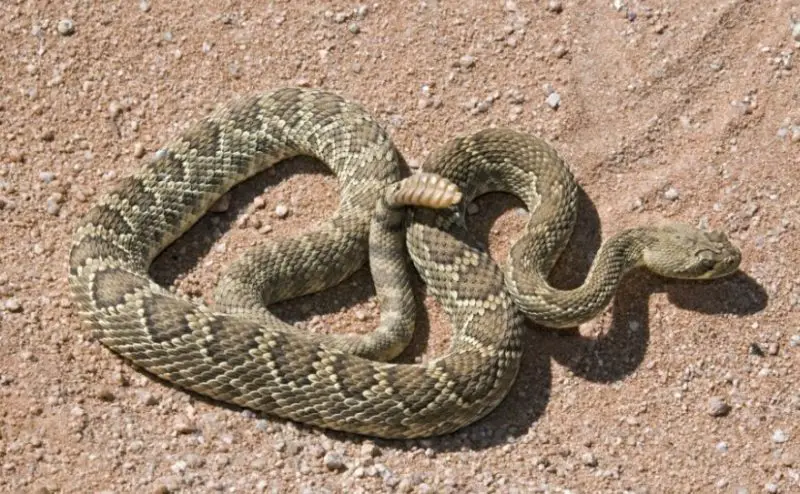
The Mojave Rattlesnake (Crotalus scutulatus scutulatus), also known as the Mojave Green Rattlesnake, is for expert keepers. With a length of 3.3 feet and a lifespan of 10 to 15 years, they sport a heavy body and a large, triangular head. Their coloration varies from brown to pale green with brown blotches.
Found in lower mountain slopes and high desert areas, they hide in shrubbery and bushes, preying on small rodents, lizards, birds, and toads, with a preference for mice, rats, and rabbits.
Eastern Rock Rattlesnake
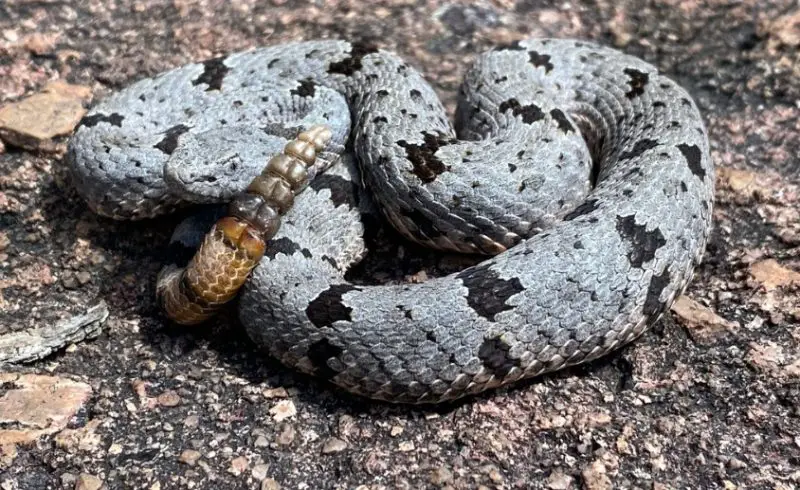
The Eastern Rock Rattlesnake (Crotalus lepidus lepidus), also known as the Blue Rattlesnake or Texas Rock Rattlesnake, is suited for expert keepers. These 32-inch snakes have a lifespan of 30 years.
Typically icy white or gray with brown or dark gray thin banded blotches and small brown dots, they inhabit arid or semi-arid climates like tropical deciduous forests and rocky flats. Unlike other rattlesnakes, they are more active in colder temperatures, feeding on lizards, small mammals, and occasionally frogs.






